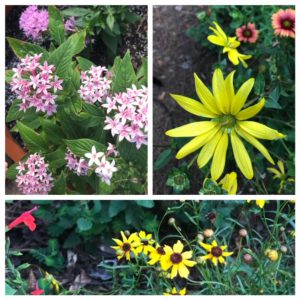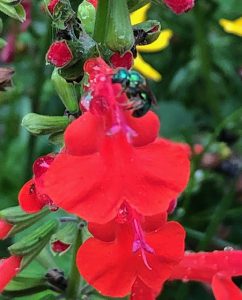Creating a maintaining a landscape that attracts desirable wildlife, such as bees, butterflies, and birds, is easy to do. Follow these simple tips to get started!

1. Start small – and have a bit of a plan. Gardens evolve over time and changes are fun to make; however, a plan of where and how to place large plants such as trees or large shrubs should provide a foundation for your landscape.
2. Learn everything you can about the needs of our wild creatures, including food, shelter, water and a home for their young. Including a diversity of plant types will increase the numbers of wildlife species that will visit your yard. (Diversity = size of plants, from trees, shrubs, perennials, annuals, wildflowers; as well as the size, shapes and colors of flowers, and time of year blooms occur.)
3. Learn all you can about the effects of chemicals on small wildlife! Limiting chemicals is critical in supporting wildlife safety in your yard. Avoid broad-based routine spraying of chemicals in your yard. Learn about Integrated Pest Management (IPM), an approach to management of plant pests using the least toxic methods.
4. Learn about Florida-Friendly Landscaping™, a University of Florida/IFAS program that promotes earth-friendly and sustainable landscaping practices. The practices are simple to follow, guiding you to create a beautiful and healthy landscape.
5. Learn about the nature of our native pollinators (for example, did you know that unlike hive-building bees, most of our native bees are solitary and non-aggressive?)
4. Learn which flower colors are best to attract bees; which colors are best to attract butterflies.
5. Learn which flower shapes are best to attract a diversity of bees, butterflies, hummingbirds.
6. Learn how to increase butterfly presence in your yard by including host plants.
8. Include Florida native flowering plants when possible. Why? Pollinators have visited Florida’s native plants for centuries, creating a close and safe beneficial relationship. Often, our native pollinators will show a preference for native flowers versus non-native.
9. Include Florida-Friendly non-native plants that are known to supply food, shelter, and/or homes for wildlife.
This blog post is part of a two-part series. To read the first post, Must Have Flowers–One gardener’s updated approach to gardening, click here.

This blog post was written by Master Gardener Molly Griner under supervision of the Master Gardener Coordinator and Residential Horticulture Agent Anne Yasalonis.
For more information, contact UF/IFAS Extension Polk County at (863) 519-1041 or visit us online at http://sfyl.ifas.ufl.edu/polk. The Plant Clinic is open Monday-Friday, 9:00 am-4:00 pm to answer your gardening and landscaping questions. Visit us in person, give us a call, or email us at polkmg@ifas.ufl.edu.
The Florida Master Gardener Program is a volunteer-driven program that benefits UF/IFAS Extension and the citizens of Florida. The program extends the vision of the University of Florida/Institute of Food and Agricultural Sciences, all the while protecting and sustaining natural resources and environmental systems, enhancing the development of human resources, and improving the quality of human life through the development of knowledge in agricultural, human and natural resources and making that knowledge accessible.
An Equal Opportunity Institution.
 0
0
